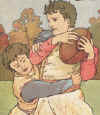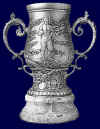|
OFFERED BY: Hunt Auctions Inc., Exton, PA.
AUCTION DATE: February 8th 2003
LOT NUMBER # 850
MEDIUM: Chromolithograph
DIMENSIONS: 12” X 16”
LITHOGRAPHER: Prang & Co.
PRINTED ON: Paper
SOLD FOR: $1,705.00 + 10% Buyers Premium
By
Carlton Hendricks
In the sports antiques world occasionally you see illustrated images of early American football; early meaning from the time of the first intercollegiate football game in 1869 to the start of WWI around 1918. Naturally, those printed in color are most desirable. Thereafter desirability is based on such features as size, art quality, artist and probably most importantly format. Format meaning whether it’s a poster, print, advertising sign or so on.
Today’s feature being in the format of a calendar is an anomaly. It is quite original in that you don’t find many calendars designed like it, having the calendar grid placed unobtrusively subordinate to the illustration within it’s borders; taking up only one eighth the image field. Obviously its one page of a complete calendar, and the publisher felt football represented the month of October especially well. Although officially it’s a calendar, its presence is that of a small poster.
The excellent overall quality of the calendar is characteristic of Prang & Co., the lithographic firm who produced it. Prang is generally
considered to have been America’s most prominent chromolithographer. Chromolithography is a form of lithographic printing in which items are printed in color. The firm’s founder Louis Prang of Boston, was the country’s most prolific and influential proponent of chromolithography during the last half of the 19th century.
The phenomena of chromolithography allowed for the first time, the mass production of colorful printed items such as posters, greeting cards, trade cards, labels, fine art prints, and calendars to be introduced into the fabric of American life. From about 1840 to 1900 the process revolutionized the country, until it was replaced by more modern and mechanized printing methods. The example seen here from 1896 would be from about the end of the chromolithographic era.
Of the many early football images I’ve seen, this ranks as one of the best. At the top of the calendar grid are the letters of the week done in the
Arts a nd Crafts style, revealing the artist’s influence. The two helmet-less players in opposing red and blue are
wearing classic football uniforms of the 1896 era, being quilted pants and lace up football smocks. L.P. Smock of Princeton invented the tight fitting canvas lace-up smock nd Crafts style, revealing the artist’s influence. The two helmet-less players in opposing red and blue are
wearing classic football uniforms of the 1896 era, being quilted pants and lace up football smocks. L.P. Smock of Princeton invented the tight fitting canvas lace-up smock in 1877. Considering Prang and Co. were headquartered in Boston, and, as we shall see, the artist lived in Cambridge, and was associated with Harvard University, its conceivable the inspiration for the red and blue may have well been the Harvard Yale game. in 1877. Considering Prang and Co. were headquartered in Boston, and, as we shall see, the artist lived in Cambridge, and was associated with Harvard University, its conceivable the inspiration for the red and blue may have well been the Harvard Yale game.
The large ball, which collectors today call a “melon” type was typical of the era. Also the long hair, particularly of the tackler was the style for football players then. If you look closely at some of the early football illustrations you’ll notice some players with shaggy haircuts. The perception was that a good head of hair helped protect the head from injuries. The year 1896 was within the transition period for headgear as it was still evolving from the initial head harness of the early 90’s. Some players still preferred playing without any, feeling they were not necessary and less than manly.
The three-tier background of the green playing field, brownish green trees, and light blue sky, provide excellent contrast and speak to the artists’ ability. At top right, the clear definition of October in a red serif font provides function while blending in well with the scene. Finally the red and goldish tones at the top of the trees unmistakably represent the fall season. However, the largeness of the players is the illustration’s greatest impression. Straightforward,
uncomplicated and stoic. It just doesn’t get a lot better that this for early football illustration !
Who was the artist of this great piece, you might ask? Well, it was a very interesting trail to find that out. In the calendar’s bottom right corner I could see what appeared to be an artist monogram. So I requested David Hunt the auctioneer to email me a
close up of it as well as the label mentioned in the description as being on the back.
Click
photo to enlarge

close
in label
The label said it was drawn by Louis Rhead. That was exciting since Rhead was one of the biggest names American poster illustrators of the 1890’s. The only thing was the monogram didn’t seem to match L.R. or anything similar.
Click
photo to enlarge

close
in monogram
And to make matters more confusing the monogram was designed in an ornate Arts and Crafts style that was hard to be sure of. It was difficult to say whether the initials were P.S.M. or S.M. or M.S. or M.P.S. or S.M.P or what ever! So I began searching for illustrators with those initials, but couldn’t match any of the possible combinations to the listed
better known poster artist of the period. And to confuse matters just a little more, it turned out Rhead had indeed designed calendars for Prang and Co.
Well, I could see see my research library was quickly being exhausted so I decided to call in the Marines. I contacted my very nice, but very busy friend Elena Millie, Poster Curator at the Library of Congress. Having Elena for a source is like telling someone you and a friend are coming over to play hoops and showing up with Michael Jordan…you’re at the pro level. Elena quickly replied with “that is not by Rhead but by Ferdinand Schuyler Mathews”. The obviously antique label had been
misinscribed.
What I was able to learn about our new friend Ferdinand was that he had been a naturalist, author, illustrator, and lecturer, and had attended the Cooper Union School in New York City for his art training. He was associated with the Gray Herbarium at Harvard University and had written and illustrated many books on nature. Some of the many he wrote and illustrated include “The Field Book of American Wildflowers” reprinted by Sterling Publications May 2002, “The Field Book of Wild Birds and Their Music” reprinted by Applewood Books May 2001 and “Familiar Trees and Their Leaves”.
The cover of
“Field Book of Wild Birds and Their Music”
which is pictured on amazon.com, would serve as another sterling example of Mathews’ exceptional ability as an illustrator. It was as good as any of the better known artists of that genre, and reminds me of the famous illustrator, Will Bradley’s work. Speaking of his quality, after realizing he authored a book on trees and there leaves, it
occurred to me why the trees in the background of today’s featured football calendar, with their fall colors, are so nicely done.
The more I’ve looked into Mathews’ background the more interesting he’s become. Without a full comprehensive study, the extent of his contributions can’t be known. However, with just a cursory overview, I found it very interesting to learn he also illustrated at least one Mcloughlin Brothers children’s book; “Plays and Games for Little Folks”. During the late 19th and early 20th century, Mcloughlin of New York City was the unequalled leading producer of magnificently illustrated and colorful
board games and children’s books; which are much sought after today by collectors. For Mathews to have illustrated for McLoughlin lends special prestige.
About the time I thought I’d acquired enough information on our boy Ferdinand, the trail became even hotter. I had typed his name into dogpile.com’s search engine and got many references. After reviewing a lot of material I pretty much felt I had all I needed and was about to exit the window, when I thought I’d look at one last insignificant looking reference
link for Campton New Hampshire’s Historical Society web
site. As I scanned the page for the Mathews name, about half way down I came across a very interesting notation
“In addition, reproductions of "Chickadees" by noted illustrator F. Schuyler Mathews have been made available by his granddaughter, Carol
Newcomb.”
I emailed the site’s contact, requesting to speak with Carol Newcomb, and hit the hay after a long day. The next morning, up at the crack of ten as usual, I had a message on my phone….it was Carol Newcomb ! I soon learned Dr. Carol Newcomb, a retired psychotherapist, was 83 years old and the only living grandchild of Ferdinand Schuyler Mathews. As it turned out she had other examples of her grandfather’s work and had recently written a paper on him but had never heard of the Prang football calendar I was
investigating.
Dr. Newcomb was kind enough to supply me first hand information about her grandfather who had lived in Cambridge Massachusetts and had kept a summer cabin in Campton where he studied nature. I also learned he went by F. Schuyler Mathews (pronounced Sky-Ler) and didn’t use the Ferdinand. She even helped me spell psychotherapist !

|
